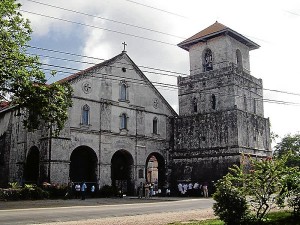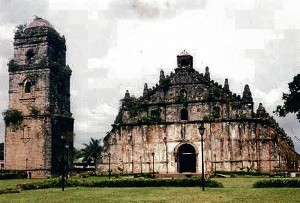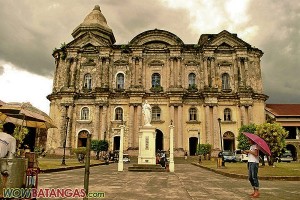Spiritual break for summer
Summer in the Philippines is not entirely about those much-awaited escapades, beach resorts and long drives.
Although this may be the perfect season to unwind and rejuvenate that weary, worn-out bod, it is also the time when Filipinos can take a “spiritual break” to nourish the soul via prayers and meditation on Holy Week.
During this period, Filipino Catholics solemnly observe a number of practices to reflect on the passion and resurrection of Christ, such as Pasyon, processions and Visita Iglesia.
If you’re thinking of churches to visit, Inquirer Property selected a number of churches you might want to consider for your annual Visita Iglesia pilgrimage.
These churches, which were chosen randomly, will not only provide spiritual nourishment, but will also serve as an aesthetical feast for your eyes with their imposing and highly impressive structures and designs.
Church of Our Lady of the Immaculate Conception
Article continues after this advertisementLocation: Baclayon, Bohol
Article continues after this advertisementThe Church of Our Lady of the Immaculate Conception is said to be one of the best preserved Jesuit churches in Bohol.
The website www.bohol.ph cites history in stating that some 200 native laborers constructed the church from coral stones, which they took from the sea, cut into square blocks, and piled on to each other.
Bamboo was also used to move and lift the stones in position while the whites of a million eggs were used to cement them together. The current building was completed in 1727.
According to the website, the church has a dungeon that was used to punish natives who violated the rules of the Roman Catholic Church. There was also an old convent, which houses a small museum with centuries-old religious relics and artifacts dating back to the 16th century.
Parish of the Holy Sacrifice
Location: University of the Philippines, Diliman, Quezon City
Built in 1955, the Parish of the Holy Sacrifice is a landmark Catholic chapel within the UP premises that has been recognized as a National Historical Landmark and a Cultural Treasure by the National Historical Institute and the National Museum, respectively.
Several national artists have collaborated to its completion: the late National Artist for Architecture Leandro Locsin designed the parish, Arturo Luz designed the floor while Vicente Manansala and Ang Kiukok did the Stations of the Cross.
Napoleon Abueva did the double-sided crucifix and altar base while Alfredo Juinio served as the structural engineer for the project.
According to its website, the Parish of the Holy Sacrifice is the first round chapel in the country and the first to have a thin shell concrete dome.
This unique design thus allows for natural lighting and ventilation. Located on its center dome is a circular skylight, which supports the triangular bell tower that extends to the interior, which meanwhile supports the crucifix.
(Source: https://www.holysacrifice.net)
Basilica Minore de San Sebastian
Location: Plaza del Carmen, Quiapo, Manila
A reflection of the late 19th century innovations in architecture, the Church of San Sebastian is the only neo-gothic church in the country and the whole of Asia, according to the United Nations Educational, Scientific and Cultural Organization.
Unesco said in its website that the church used a steel frame and panels that were manufactured in the Societe Anonyme’s foundry in Binche, Belgium.
Stained-glass windows were also imported from German stained glass firm Henri Oidtmann Co., while Trompe l’oeil paintings were used to decorate the interiors of the church.
The Church of San Sebastian has been declared a National Historical Landmark and was listed among the 1998 World’s Most Endangered Sites by the World Monuments Watch.
(Source: https://whc.unesco.org)
Paoay Church
Location: Paoay, Ilocos Norte
It is one of the oldest churches in the Philippines that has been inscribed in the Unesco World Heritage list given its unique architectural style—a reinterpretation of European Baroque by Chinese and Philippine craftsmen.
According to its website, the Paoay Church has a façade that revealed Gothic affinity; its gables showed Chinese elements while the niches topping the walls suggested Javanese influence, reminiscent of the famous Boroboudur Temple.
Its fortress-like structure with 24 massive buttresses designed to withstand the destructive forces of earthquakes has also given the church its “Earthquake Baroque” title.
Meanwhile, a three-story coral stone bell tower stands a few meters away from the church. A panoramic view from the top of the bell tower shows a vast expanse of land until it merges with China Sea, the website further noted.
(Source: https://pasyalan.net/
ilocos_norte/paoay)
San Agustin Church
Location: Intramuros, Manila
It was the first church built in Luzon in 1571 that had then served as the Augustinian mother house in the Philippines. This is why it was endowed with a fine retablo, pulpit, wall paintings, lectern and choir-stalls, according to Unesco.
Having survived the liberation of Manila in 1945, the San Agustin Church is now considered as the oldest stone church in the Philippines—the only one that remains as an original evidence of the 16th century Spanish architecture.
Unesco noted that the structural design of the church is extraordinary as it boasts of a barrel vault, dome and arched vestibules—all made of stone.
The main door, carved out of Philippine molave, has a bas-relief of St. Augustine and his mother, Santa Monica. It has been declared as a World Heritage Site by Unesco.
(Source: https://whc.unesco.org/)
Basilica de San Martin de Tours
Location: Taal, Batangas
Regarded as the largest in Asia, the Basilica de San Martin de Tours church stands 95 meters long and 45 meters wide on a plateau in the heart of Taal.
Augustinian missionaries started the construction of the church in 1756 and took a century to achieve its present form, the website www.thebestoftaalbatangas.com stated.
The church is famous for its façade that resemble the St. Peter’s Basilica in Rome, while the interior is in the form of a Latin cross with wide aisles on each side containing the small retablos and carossas. Its tabernacle, the only one of its kind in the country, is made of silver.
(Source: https://www.thebestoftaalbatangas.com)
Church of Santo Tomàs de Villanueva
Location: Miag-ao, Iloilo
The Church of Santo Tomàs de Villanueva in Miag-ao is among the best examples in the Philippines of the “fortress baroque” style, according to the Department of Tourism website.
Standing on the highest elevation of the town, the church boasts of a massive pair of bell towers and angled buttresses that strengthen its fortress image.
The façade of the church is considered a Filipino masterpiece with unknown master carvers having incised the entire surface. The church of Santo Tomàs de Villanueva is one of the best examples of the fusion of the western Baroque style embellished with Filipino folk motifs.
In 1993, the Miag-ao church was included in Unesco’s World Heritage List under the title “Baroque churches of the Philippines.”
(Source: https://www.tourism.gov.ph)






